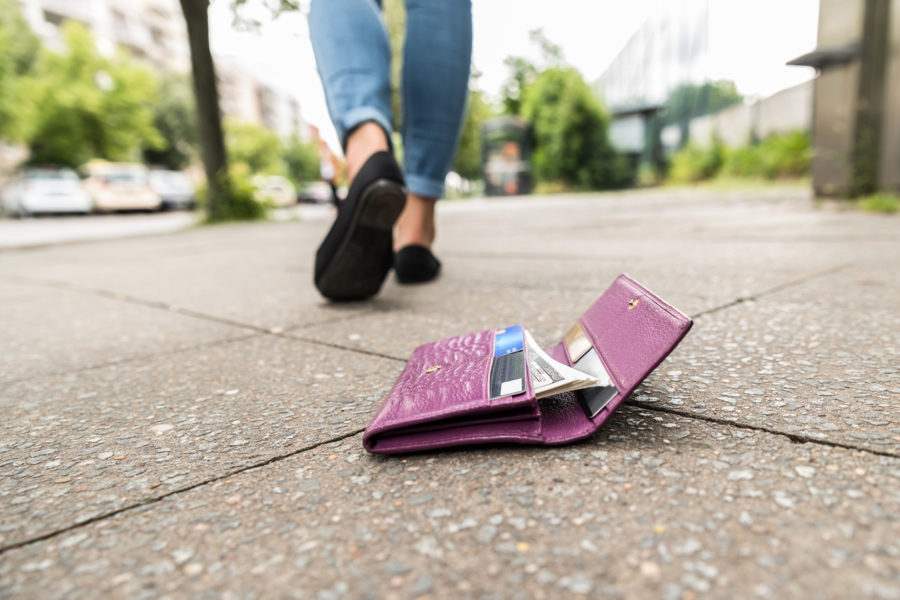It’s Monday morning. To start the week off on the right foot (and put your staff and colleagues in a good mood), you decide to pick up some doughnuts and coffee for the entire office on your way in. You go to pay, and… that’s weird… your wallet is nowhere to be found. Panic sets in. Did you forget it at home? Did a pickpocket snatch it from your purse? Perhaps you dropped it somewhere on your commute?
Wherever it is, it’s not in the right place, and you’re feeling frantic. Now what? You need to take action — fast. Here are seven steps you should take when you’ve lost your wallet.
Step 1: Try To Find It
The first thing to do after you lose your wallet is to try to find it. While that may seem obvious, it’s all too easy to go into panic mode and spend tons of effort replacing everything — only to find your wallet tucked beneath a couch cushion a day later. A little upfront detective work could save you a lot of stress.
Calmly think about the last place you remember seeing it. Then, retrace your steps from that moment forward. Call every business you visited between then and now to see if anyone’s turned in your wallet. Scour your house, and ask your family if they’ve seen your wallet anywhere.
If it truly is gone, you’ll need to get proactive to make sure nothing in your wallet will be useful to a potential thief.
2. Call Your Banks And Credit Card Companies
Having your credit and debit cards floating around leaves you at risk for serious financial damage. Call your banks, credit card companies and other financial institutions to report that your credit, debit and ATM cards are missing. They’ll generally have a toll-free number exclusively for reporting lost and stolen cards listed on their websites.
Each company has its own process for dealing with missing cards, but generally, they’ll close down the accounts and replace them with a new account number and debit or credit card.
“A lot of credit and debit cards will be replaced within a couple of days to a week. Some banks can also replace your cards in a local branch that same day,” said Todd Christensen, education manager at nonprofit debt relief agency Money Fit by DRS, and author of “Everyday Money for Everyday People.”
Keep in mind that if you have automatic payments set up, you’ll need to update your payment method to avoid going past due and incurring late fees.
3. Freeze Your Credit
A wallet with a social security card, driver’s license and other personal information is a gold mine for an identity thief. He or she could use that information to borrow money or open new cards in your name. Protect yourself by freezing your credit with each of the three major consumer credit reporting agencies: Equifax, Experian and TransUnion.
“With a credit freeze, no lender can open an account with your information on it or look at your credit report unless you temporarily thaw your credit using your PIN,” said Christensen.
It’s a good idea to monitor your credit for fraudulent activity over the next few months. You can get free credit reports at CreditKarma, Annual Credit Report and through some bank websites.
4. Replace Your Driver’s License And Insurance Cards
Chances are good that your wallet didn’t just contain credit cards — it also had your photo ID. You’ll need to report your driver’s license as lost and order a replacement through your local DMV. Each state’s DMV has different requirements for replacing a license, but you may need to pay a fee and supply other proof of identity. Check the website of your local DMV for details.
Did your wallet contain your health or dental insurance cards, as well? Give your insurance companies a call right away. Medical identify theft is on the rise, and it could cause errors on your health records and leave you with bills for expensive medical services you never obtained.
5. Spread The Word About Your Missing Wallet
Your wallet might be missing, but that doesn’t necessarily mean it’s gone for good. A recent survey of more than 1,700 people found that “29 percent of people have had their lost wallet or purse returned to them.” Start getting the word out by alerting the authorities.
“Filing a police report will help if someone does find your wallet,” said Christensen. “Even if it’s missing your ID when it’s turned in, the police may be able to find you in their records.”
Social media may also help you track down a lost wallet. Post a description of your wallet, as well as other helpful information (such as where you may have lost it), on Facebook, Instagram, Twitter and other networks.
“Another option might be using neighborhood-focused apps, like NextDoor. I’ve personally seen people on the app get things back that they’ve lost. It also wouldn’t hurt to notify your neighbors,” said Christensen.
6. What Not To Worry About
Replacing every last item from your lost wallet can be time consuming, if not downright impossible. Things like grocery discount cards, library cards, business cards and that loyalty punchcard from your favorite cafe can be dealt with on an as-needed basis as you rebuild your wallet. Right now, focus your energy on taking care of the most important stuff, like your driver’s license and credit cards.
7. Streamline Your New Wallet
Treat yourself to a new wallet once this is all behind you. As you begin to fill it up, take some precautionary steps to minimize potential damage if this one is ever lost or stolen.
“I recommend people carry as little as possible in their wallets. You can convert a lot of your credit cards and rewards cards to a digital format, protected by a password vault on your phone,” said Christensen.
You could also consider tucking a small Bluetooth tracker, like Tile, into one of the pockets of your new wallet to help you locate it if it’s missing.
Everyone misplaces things from time to time. While losing your wallet is far from fun, the good news is that the majority of its contents are likely replaceable with a few phone calls.



 5 min read
5 min read


